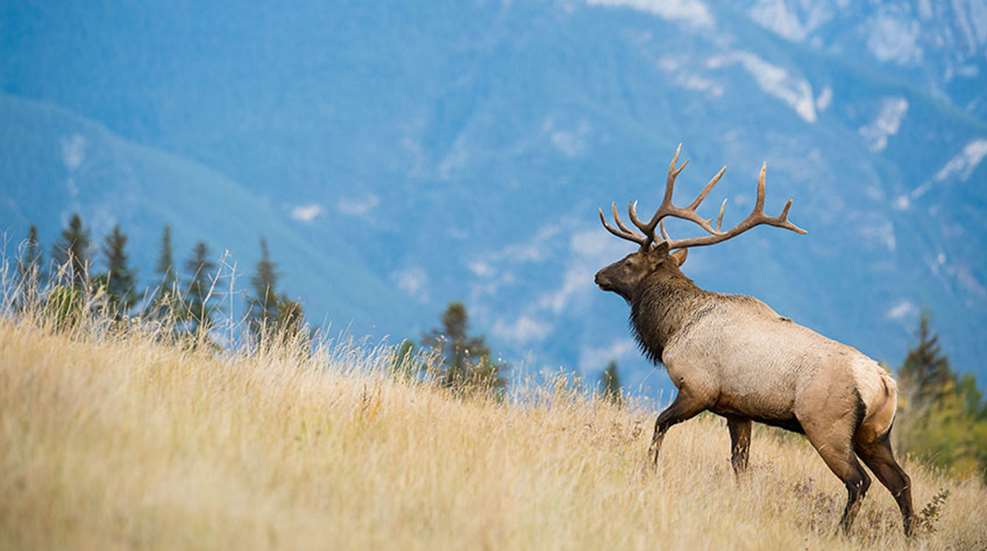
That didn’t sound right, I thought to myself between the crunches of trail mix. I’d just dropped 500 feet in hopes of intercepting a very vocal herd bull. Unfortunately, in accordance with the unofficial “Elk Hunting Manual” the elk shut up on cue at my arrival. With no elk in sight and no auditory prompts to follow, I still-hunted up to a secluded bench in dense, dark timber. I’d stumbled across the location previously while following bugles. It was quite apparent from the circular beds, fresh droppings and lingering barnyard smell that elk had staked a claim to the lodgepole address.
With my chewing in park, I slowly scanned the surrounding timber and almost spit out my half-munched mouthful of mix. A bull elk was rooting around in the forest duff at 20 yards to my hard left. His next move was even closer, and behind him the herd appeared totally oblivious to my stupefied, camouflaged form. In seconds he rambled to 12 yards, and the future prospects of white packages of elk filets suddenly began to look much better.
Choosing this location to take a rest wasn’t haphazard on my part. Not only was the elk sign a tip-off like a notice that reads “Fresh Paint,” but also I knew my midmorning break might coincide with elk looking for a daytime hostel.
Understanding how elk utilize terrain directs you to great ambush sites.
Ask Andy Holland. Part of Holland’s job as a big-game manager for Colorado Parks and Wildlife (CPW) is to study elk. To analyze elk behavior, Andy has to find them. He’s been doing that for 17 years now. Studying terrain with an elk mindset helps him excel at his position. It also doesn’t hurt that Holland grew up in Montana’s elk country and has been hunting the leggy ungulates for more than 30 years.
“Elk discover terrain that helps them avoid people by trial and error,” states Holland. “Once they find an area where they stop getting bumped, they’ll stay longer. And you have to remember, some of these cow elk have been playing this game for 20 years. They have 20 years of history that includes our hunting season structure and hunter behavior. They know more than we give them credit for, and they remember where to go when they want to avoid people.”
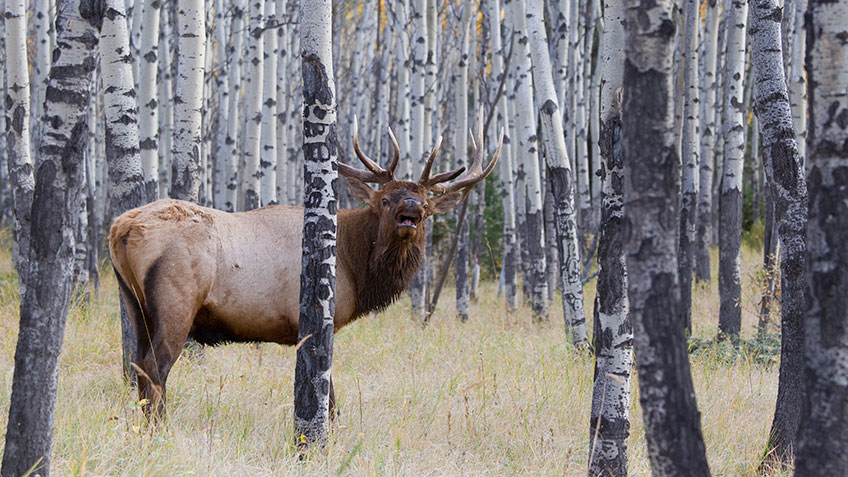
Much of Holland’s insight comes from years of radio-collar data after studying the White River elk herd, where CPW experimentally manipulated hunting season dates and hunter numbers. Information from this study is one reason why Colorado has a break between archery season and the first firearm season. Data indicated the break prompted elk to return to public areas they left because of earlier hunting pressure.
“The break between archery and firearm season allows them to redistribute to public hunting areas where they may have left earlier,” Holland points out. “They absolutely can tell when there is no hunting pressure, and the break makes them more accessible in the following hunting seasons,” says Holland.
Holland also points out that hunters are not the only human source of pressure. Elk country recreationalists, a growing concern among wildlife managers, also spur evasive moves. ATV riders, hikers, mountain bikers, trail runners and others place pressure on elk in addition to hunters. Pleasant weather in early fall invites more and more outdoor lovers into elk habitat.
“It’s important for people who are birders, bikers or hikers, and others who feel they have no impact on the resource to understand: you probably do have an impact. Everyone has some impact if they’re spending time in the outdoors,” notes Holland.
Whether your fellow hunters or rambling robin watchers spook elk, rest assured the elk will respond with a champion game of hide-and-seek by utilizing terrain. The following five terrain features attract elk. Compare them to what you find in your elk hunting area for a tactical boost in your strategy this fall.
Opening Opportunities
A herd of elk requires a vast supply of vegetative nutrition to sustain health. Primarily grazers, elk do browse on forbs, shrubs and other woody plants throughout the winter months. Depending on the size of the animal, they may require 12 to 20 pounds of vegetation daily. Think of them like your uncle’s small herd of dairy cattle and you’ll get an idea of the importance of grazing in their daily schedule.
By early fall many grass species have dried out and elk begin to add more shrubs to their diet. Nevertheless, a herd typically makes a pit stop at the nearest open area to snatch some grass as a complement to other meal options. Your goals are to discover what elk are feeding on and when they plan to make a dining reservation.
Since elk country varies from region to region, the areas where elk feed also may vary. Meadows and park openings play an important role for elk living in dense conifer settings. Limited light reaches interior cover, thus limiting grazing opportunities beneath the branches. In areas where aspens or scrub oak flourish, Holland notes that elk can and may prefer to graze within the cover itself. The open nature of the canopy allows more sunlight to reach the ground, thus prompting adequate vegetation growth for elk grazing within a veiled refuge.
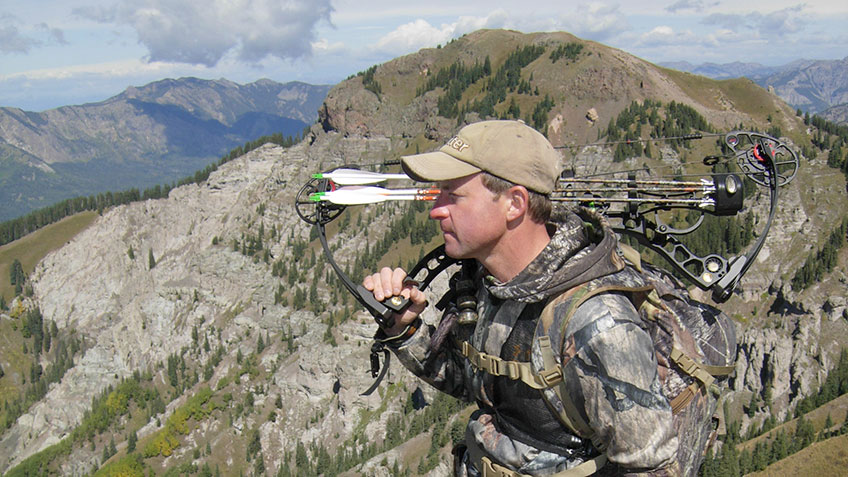
“In aspen country, a lot of times the forage quality is significantly better in the aspen groves than what’s available in the meadows,” says Holland. “It kind of depends on what sort of terrain you are hunting elk in. In higher-elevation settings the meadows and openings provide a lot of the forage for elk if the alpine component is missing, but at somewhat lower elevations the aspens and oak brush fill the need.”
Hunting pressure dictates whether you can wait on the edge of an opening in whitetail-like fashion to waylay an elk. Herds prefer to rut and roam in the open, but not if they are harassed. One season I followed a herd at sunset nearly back to my camp with no archery opportunity. Not long after dark the party started in a meadow less than 200 yards from camp. Bugling continued all night, giving me confidence for the morning hunt. But just before shooting light the herd zipped the lips and left in silence. That’s more common than not. Be ready to hunt them with other terrain help.
Winning Passes
Elk can outmaneuver a Baja racing truck, but they will take an easier route rather than run straight up and over a mountain. Saddles and passes provide travel conduits through the mountains.
A quality topographic map or topographical overlays on satellite images quickly display those low spots between mountains elk may use in your hunting area. My ScoutLook Weather hunting app includes all this, plus property ownership information. Zoom in on satellite images and they often reveal eons-old trails traversing the passes if enough open space allows for a peek from above. If not, navigate by foot power to inspect the hunt-worthiness of any prominent saddles.
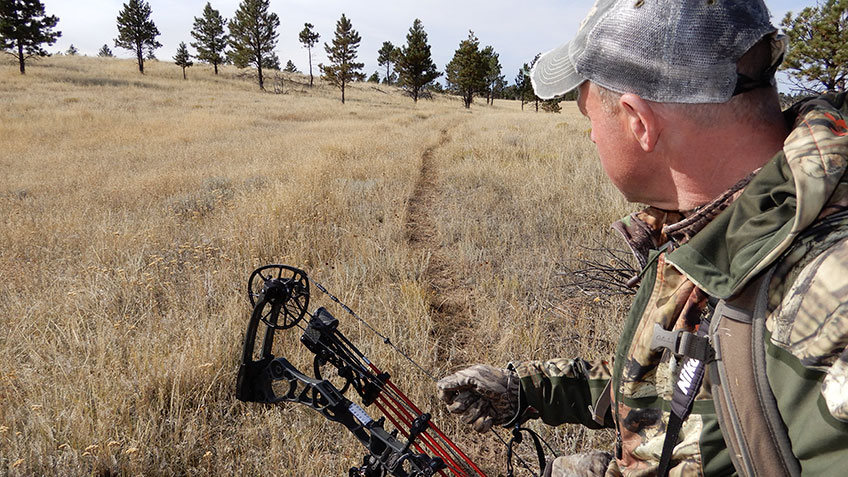
If your inspections reveal a fresh traffic pattern try to determine usage times. Are elk using the low spot as a corridor between a major feeding area and bedding cover? Are elk using it to escape pressure in nearby areas easily accessed by other hunters or recreationalists? Are elk simply using the pass to journey through elk country?
“Elk are going to use those passes for travel for a couple of reasons,” outlines Holland. “First, passes are often timbered and they offer some security to move easily in an area. They are also the quickest route to travel from one drainage to the next. Herds use them, and lone bulls searching for cows, or cow groups routinely pass through them.”
Finding a well-beaten path through a saddle could give you reason to pause. It’s an ideal location to ambush elk or even take a break with an opportunity for elk to appear in the natural funnel at any point during shooting light.
Grand Canyons
Saddles and passes routinely dive into the next canyon. Any large abyss meets the next criteria for a terrain feature to attract elk. Canyon chasms tempt elk for several reasons. At the bottom elk may find water (a herd of elk doesn’t hydrate on morning dew alone). Also, elk may find enough vegetation bordering many wet areas to top off an evening of grazing.
Sustenance aside, vertical canyons with naturally occurring, shaded, north slopes provide ideal refuge. The steepness factor alone causes many wannabe elk hunters to stand at the top and listen to bugles that do not ascend. Dense stands of timber on an old-growth north slope allow elk to disappear like a doughnut in the office breakroom. And as fall progresses any open south-facing slope suddenly becomes the next stop for fuel as other food sources are depleted or wither.
“Elk dig in when they find a rugged, steep canyon,” Holland says. “Even so, you can have too much of a good thing. The canyon still has to offer benches for bedding to make it attractive to elk, to make them want to stay in the canyon.”
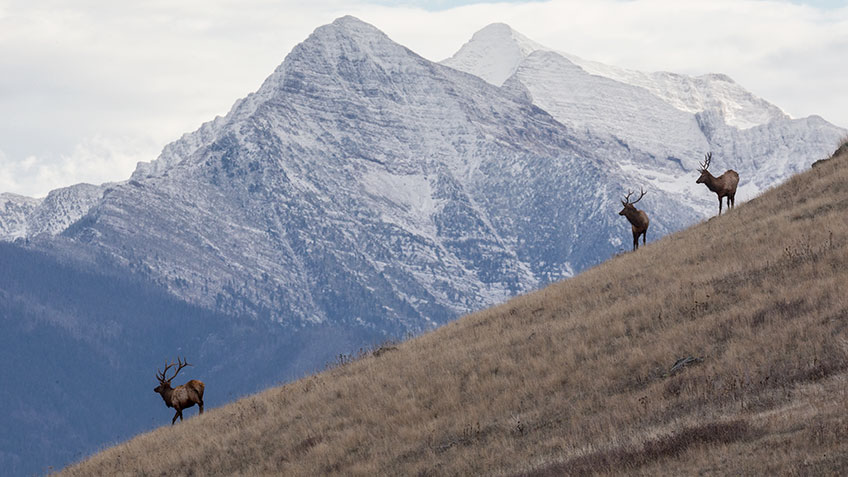
So what’s ideal for steepness? Holland reveals two factors he looks for when assessing canyon country. First, if it is too steep for road building it’s a likely candidate for an elk stopover. Fewer roads equal fewer human visitors, including hunters. Second, if the steepness inspires hunters to say, “I’m not going down there! If we get an elk how do we get it up here?” he notes it as a place to investigate.
Holland also makes this point: Finding elk in steep country is often easier than in rolling lowlands. In steep country elk are forced into limited areas and glassing is more effective. Rolling terrain allows elk to scatter and disperse, making locating them a more difficult chore.
Mesa Meccas
Another prominent terrain feature, which opens every classic Western movie, is the mesa. Flat-topped highlands, these pinnacles come in a variety of formations and sizes. Generally they are characterized by steep sides and are skillet-flat across the top. The slopes may be too steep for forestation, although north slopes often have a dense stand of junipers or cedars. Depending on the latitude, conifers can be found on the top in varying degrees of density. Most importantly, mesas typically include openings that provide elk with grazing opportunities.
To rate a mesa consider the following. First, is it easily accessible? Roads and major hiking trails pave the way for simple human access. That means elk may use the mesa, especially if good grazing resides at the top, but they may vacate it well before shooting light. On the other hand, a rugged mesa with no developed roads could be holding elk 24/7.
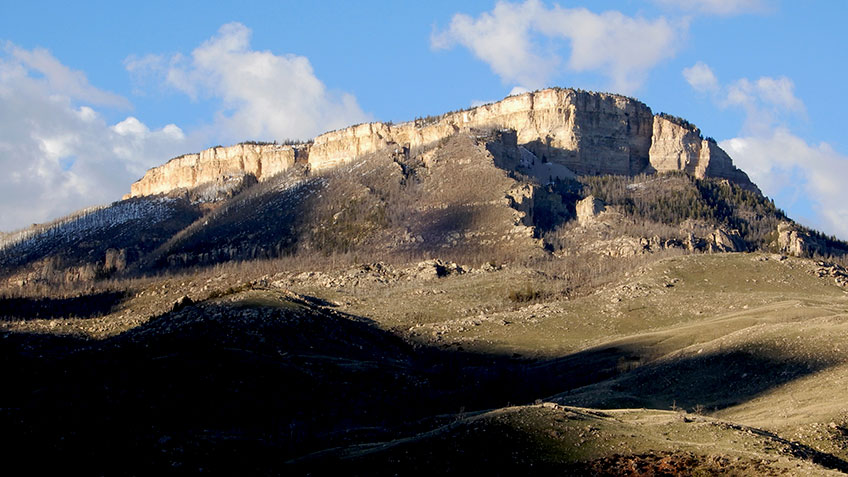
Secondly, is the mesa isolated from other elk habitat? Lonely mesas scattered across otherwise generic, sagebrush country attract elk. You may not see elk hidden in the pines, but an entire herd could be sheltered on the feature with an out-of-sight, out-of-mind attitude.
“In our mesa country of western Colorado the mesas, by definition, also have canyons associated with them,” says Holland. “That equals good escape options, and when you combine that with the forage opportunities on top it’s likely you’ll find elk there.”
A friend of mine told me about just such a place. He was early-season hunting with his son when they spotted elk up on a mesa, and they worked the wind to summit. Once on top they found dozens of elk feeding leisurely at the center of the flattop. One shot later they’d dropped a beefy cow, but the herd quickly dropped off the far side. Hustling over to the edge, they discovered the herd wasn’t leaving but circling low and coming up a far finger on the opposite side of the mesa. With another strategic move they met the ascending herd and filled a second cow tag to begin a long day of meat recovery on a mesa the elk just wouldn’t leave.
Shady Benches
So what’s the winning terrain feature for hard-earned elk success? Any of the above can generate an elk-steak dinner depending on region-specific makeup, but for Holland one feature stands apart. He believes benches, especially those hidden from view under the canopy of timbered, north-facing slopes, are the winning ticket.
“If I’m just going to look at a topo map to choose a terrain feature to hunt, my number one choice would be to study a given area to locate any benches,” he says. “If there are elk in the vicinity you can quickly and fairly easily find elk on benches, even in the middle of the day.”
To narrow down your choices, Holland says, research benches that reside on steep, dark slopes. According to his experience, benches hidden under a screen of old-growth timber are preferred, especially those adjacent to quality forage and water, which connect to other travel routes.
In fact, Holland’s favorite hunting location fits this description perfectly. He and his hunting friends call the hidden bench the “fortress.”
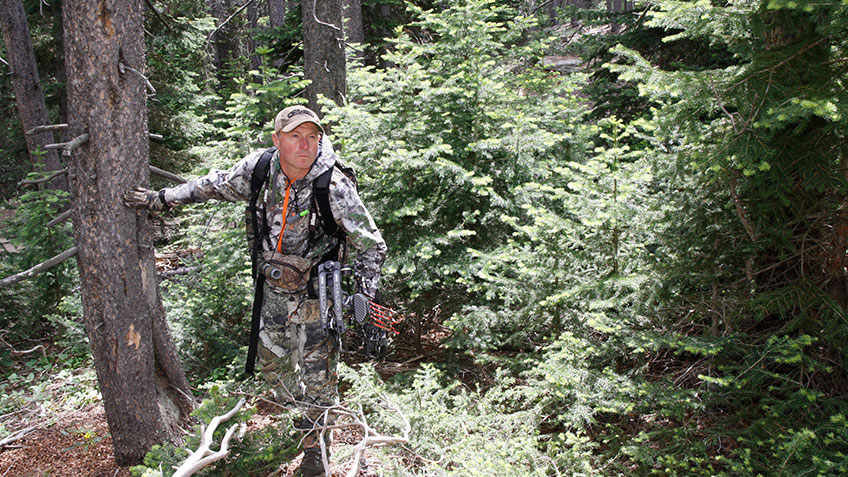
“We call it a fortress because it is surrounded by steep, rough country and it’s challenging to kill one there,” he admits. “It’s hard to ambush them because they often catch you sneaking in and you blow them out. Swirling mountain winds and multiple bulls using the bench add to the difficulty of finding success. Still, whether the elk are feeding above or below the bench, they prefer to slip in there and hide out for the day. You can always find them there.”
My bench resting spot was getting quite heated even under the shade of towering pines. With the bull at a mere 12 yards the quartering-to shot still wasn’t a green light. Luckily the rest of the herd passed below the bull and he sashayed toward them, opening up his vitals to a quartering-away option.
I never sit down without an arrow nocked and my bow between my legs. Today was the same. In one smooth motion I lifted and drew my Mathews bow. The bull paused to look at the passing herd, and I sent an arrow from a seated position.
The elk bolted but went into wobble mode in seconds, giving me the satisfaction of watching him topple into the limbs of a downed snag. From start to finish the entire encounter lasted less than 10 minutes, and I owe it all to terrain that created the perfect location for meeting one of North America’s cagiest creatures.
Camouflage for Elk Country
Whether carrying a bow or a firearm, you must disappear in elk country. Some terrain tactics require a full-frontal assault that places you within feet of elk. Combine that with an elk’s eyesight, its sense of smell and its hearing, and you already have a date with failure. You must camouflage your form and your scent.
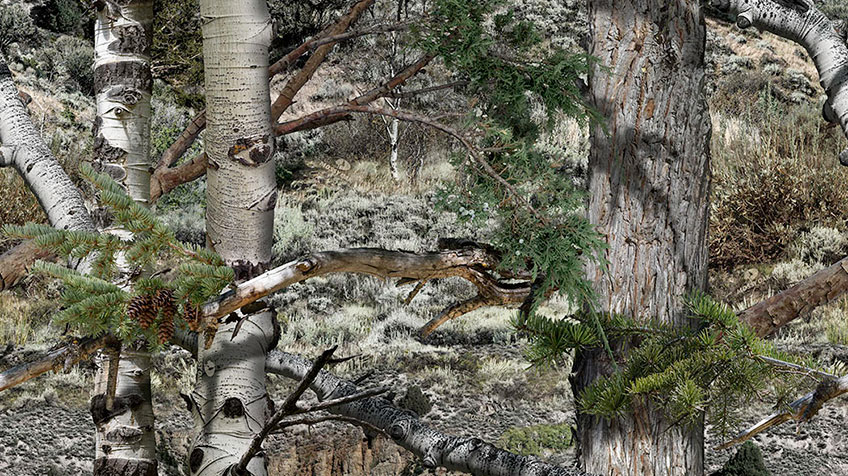
Mossy Oak designed Mountain Country to meet the demands of Western hunting. It utilizes digital technology to melt into the backdrop of unique Western landscapes by combining images of conifers, aspens, pine boughs, rocks and the distinct look of sagebrush. This innovative pattern allows hunters to disappear in the high country or foothills of the West. For more information, go to mossyoak.com.
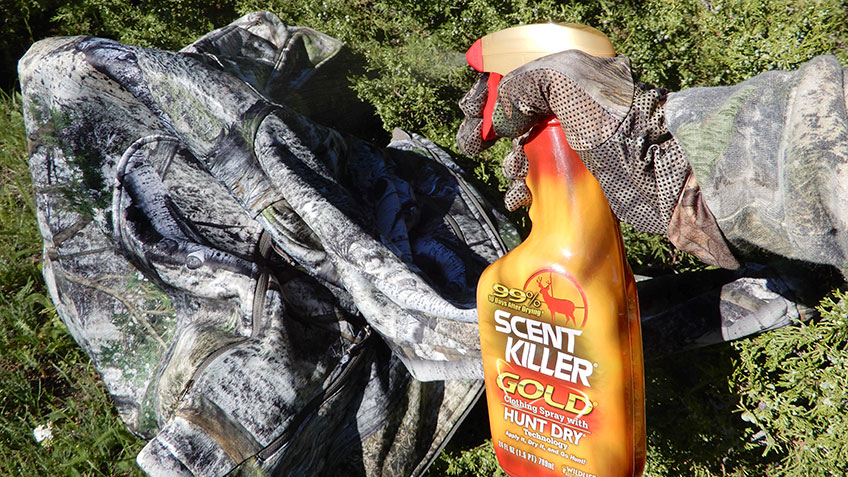
Elk hunting is a sweat fest. It’s nearly impossible to stay scent-free during the hunt. A proactive approach now will help keep you invisible in elk country later. Use Wildlife Research Center’s Scent Killer Gold. Spray it on your clothing and gear before your hunt, and let it dry. It’s been tested to stop human odor for up to 20 days after drying. For more information, to go wildlife.com.




































